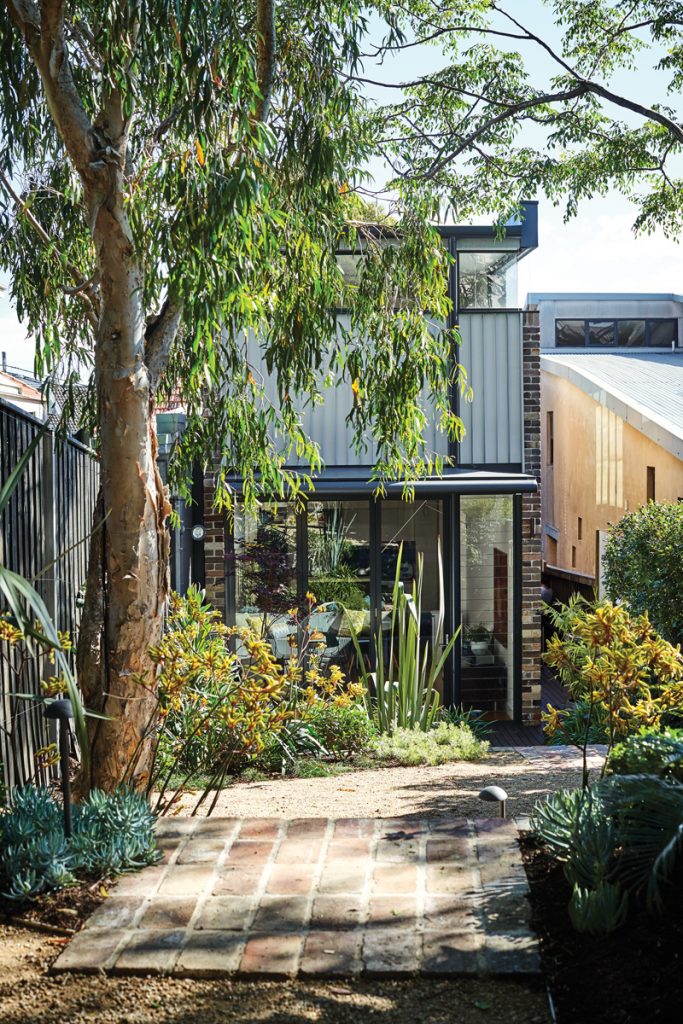Depth Of Field
Behind many inner-city properties are long, narrow rear gardens, and while “long” is an attribute worth having, denoting depth, “narrow” is a much less desirable dimension.
This northeast-facing garden behind an early 1900s semidetached house in an eastern beachside suburb of Sydney is both long (20 metres) and narrow (5 metres). It also has a fall of about 4 metres in height from the rear fence down to the back of the house, which has been renovated and now opens out onto a timber deck.
When Nicola Cameron of Pepo Botanic Design was called in to see the rear garden, she found that the garden beyond the deck had already been divided into three grassed terraces, with the upper terrace (home to the washing line) partially screened from view by a clipped hedge of lilly pillies (Syzygium australe).
The timber paling fences on either side of the garden were bare, highlighting the narrowness of the block, and behind the rear fence was a large, unattractive house that needed concealing. But Nicola also discovered that the garden was home to four mature native trees: a lacy white cedar (Melia azedarach), a graceful weeping paperbark (Melaleuca leucadendra), and two slender gum trees (Corymbia citriodora) planted near the back fence.
“The owners wanted to get rid of all the lawn and have garden spaces that enhanced the depth of the garden,” says Nicola. “Apart from the existing trees and the lilly pilly hedge that really divided up the space, the only other plants were a few clumps of lomandra. The owners had seen one of our other gardens and they wanted their garden to be more botanical and diverse.”
They also wanted to lose the white cedar, but Nicola argued for its retention. “The cedar is really important,” she says. “To lose it would change the way the garden works. When you walk in here on a hot, steamy summer’s day, that tree really does give you a ‘hug’.
It encloses the space, providing relief from the surrounding urban density. It creates dappled shade and heightens the feeling of being in a garden. It has a very strong purpose that tree.”
Because of the white cedar and the other established trees the terraced levels could not be changed, but Nicola and her colleague, landscape architect Eva Valensise, linked them with a meandering path in decomposed granite that slices diagonally across the garden on the middle and upper levels, visually widening the space. The terraces were then linked with steps paved in neat grids of recycled bricks that complement the materials used in the house’s rear extension.
The boundary fence-lines were screened in a variety of ways: a lilly pilly hedge to the west, a row of weeping lilly pilly (Waterhousea floribunda ) at the rear, and a fragrant climber (Stephanotis floribunda ) trained along the eastern side of the deck. To provide more coverage than the Stephanotis is currently giving, the native climber (Pandorea pandorana) will soon be added to this side. The remaining ground space was carved into garden beds, built up with cow manure and compost, and planted out with a mixture of natives and exotics — a lush and textured plant palette that really celebrates Sydney’s sub-tropical climate.
On the native side of the ledger are the lilly pillies, as well as kangaroo paw (Anigozanthos ), flax lilies (Dianella tasmanica ), native ginger (Alpinia caerulea ) and cordylines, and a pretty, prostrate Albany woolly bush (Adenanthos cuneatus ) that tumbles over the off-form concrete retaining walls around the edge of the deck.
Introduced exotics include clipped Indian hawthorn (Rhaphiolepis indica ), a handsome New Zealand flax (Phormium tenax ), spiral ginger (Costus barbatus ), cycads (Cycas revoluta ), the succulent known as blue chalk sticks (Senecio serpens ), and velvety black elephant’s ears (Colocasia esculenta ). As well as the rich and varied planting palette, the various spaces within the garden have each been given a distinctive character and purpose. On the lower level, a water bowl tucked into the greenery adds a soothing note, while on the upper level (now with a demountable clothesline that can be packed away when not in use) a fire-pit and gabion bench seat provide a reason to linger. From this vantage point there are views back down through the garden, as well as right through the house, highlighting the one dimension this block has in abundance – depth.
“At night, the garden lights accentuate the really lovely journey there is now through the space,” says Nicola. “The key was offsetting the paths so that they create an amble through what is really quite a small space. It’s not a huge garden so we’ve tried to make it look bigger than it is and provide reasons to pause as you wander through it.”








